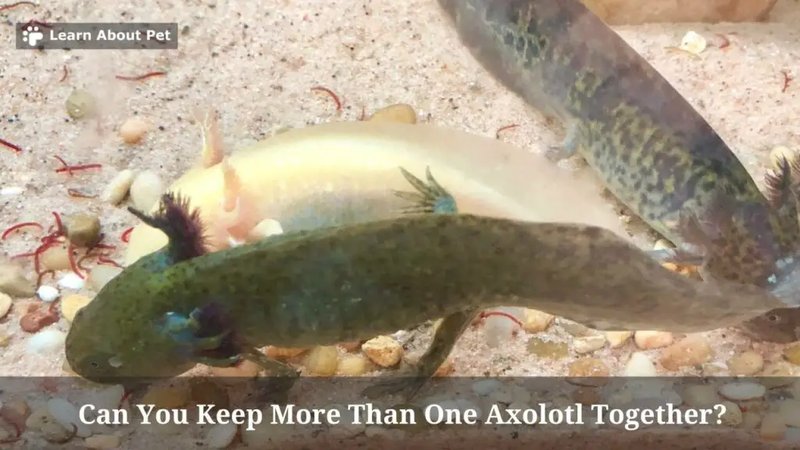
To begin, axolotls are fascinating amphibians with a somewhat tender nature. They thrive in environments that mimic their natural habitat, which is typically a peaceful lake in Mexico. When thinking about housing multiple axolotls, it’s important to understand their needs and behaviors – much like considering the dynamics at your dinner table. In this article, we’ll break down how to keep axolotls, discuss group living, and pinpoint what you need to ensure your aquatic friends are happy and healthy.
Understanding Axolotl Behavior
Before jumping into whether you can keep axolotls together, it helps to understand a bit about their behavior. Axolotls are naturally solitary creatures. In the wild, they’re not known for forming schools like some fish do. Instead, they prefer to roam their territory alone. This gives you a hint: putting multiple axolotls in one tank can be a bit like throwing a few introverts together at a party—they might not enjoy it.
Here’s the thing: while some axolotls can live peacefully together, others may not get along at all. You might find them ignoring each other or coexisting peacefully. But in other cases, they can become territorial and aggressive. Imagine inviting that one friend who always stirs the pot; it can lead to a lot of unease in the tank.
Keeping an eye on their behavior is crucial. If you notice tension—like one axolotl constantly chasing or nipping at another—it’s a clear sign they need their own space.
Tank Size and Environment
If you’re set on having more than one axolotl, the size of their tank plays a critical role. A bigger tank means more space to explore, which can help reduce conflicts. Ideally, you should have a tank that is at least 20 gallons for one axolotl, and you’ll want to add an extra 10 gallons for each additional axolotl.
Think of the tank size like a big living room: the more space everyone has, the less likely they are to bump into each other. In a cramped environment, they’re going to feel stressed, leading to fights or even health issues.
When setting up the tank, consider adding plenty of hiding spots. You can use decorations, plants, or caves. These give your axolotls places to hide and retreat if they feel threatened, which is vital in preventing stress and aggression.
Choosing the Right Companions
Not all axolotls are created equal, and their behavior can be very different based on coloration and size. For instance, younger axolotls are often more playful, while adults may establish a pecking order. Mixing different sizes can cause issues, as larger axolotls might see smaller ones as potential snacks.
It’s generally suggested to keep axolotls of similar sizes together. If you have a baby axolotl, it might be best to wait until it’s grown before introducing another. You wouldn’t want to end up with a tank where one friend is always getting picked on!
In terms of coloration, some folks believe certain colors, like leucistic or golden, are friendlier, but this isn’t a guarantee. The individual personality is the key here.
Monitoring Health and Stress Levels
Keeping axolotls together isn’t just about compatibility; it’s also about their health and general well-being. Stress can lead to serious health issues in axolotls. Here are some signs to look out for:
- Hiding constantly: If one axolotl is always hiding, it might be a sign of stress.
- Loss of appetite: If an axolotl stops eating, it could indicate they’re not comfortable in their environment.
- Physical injuries: Look out for any signs of bites or damaged gills.
Remember, if you spot any of these signs, it’s essential to act quickly. It might mean separating the axolotls or even adjusting the tank setup to help create a more peaceful environment.
Best Practices for Group Living
If you decide to go ahead and keep multiple axolotls, follow some best practices to ensure harmony in your tank:
1. Introduce Gradually: If you’re new to keeping axolotls, try introducing a new axolotl slowly. Set up a separate tank for the newbie at first to ensure they’re healthy and to gauge compatibility.
2. Watch Their Interactions: After introducing a new axolotl, keep a close eye on their interactions for at least a week. If you notice any aggressive behavior, it may be time to separate them.
3. Regular Maintenance: Clean the tank regularly and keep the water quality high. Stress levels can increase with poor conditions, leading to conflicts.
4. Feeding Time: Feed axolotls in separate areas if possible. This reduces competition and ensures that everyone gets their fair share of food.
By following these guidelines, you can create an environment where your axolotls can thrive together—or at least coexist without constant turmoil.
Final Thoughts on Housing Axolotls
So, can you keep more than one axolotl together? The answer leans towards yes, but with caution. Understanding their nature, providing a spacious and enriched environment, and monitoring their behavior closely can lead to a peaceful coexistence. Just remember, every axolotl is different, and what works for one pair might not work for another.
Ultimately, your goal is to create a happy and healthy home for your axolotls, where they can thrive without too much stress. Whether you choose to keep them together or separately, just ensure you’re giving them the best life possible. It’s all about observing, adjusting, and enjoying your unique little aquatic friends.

